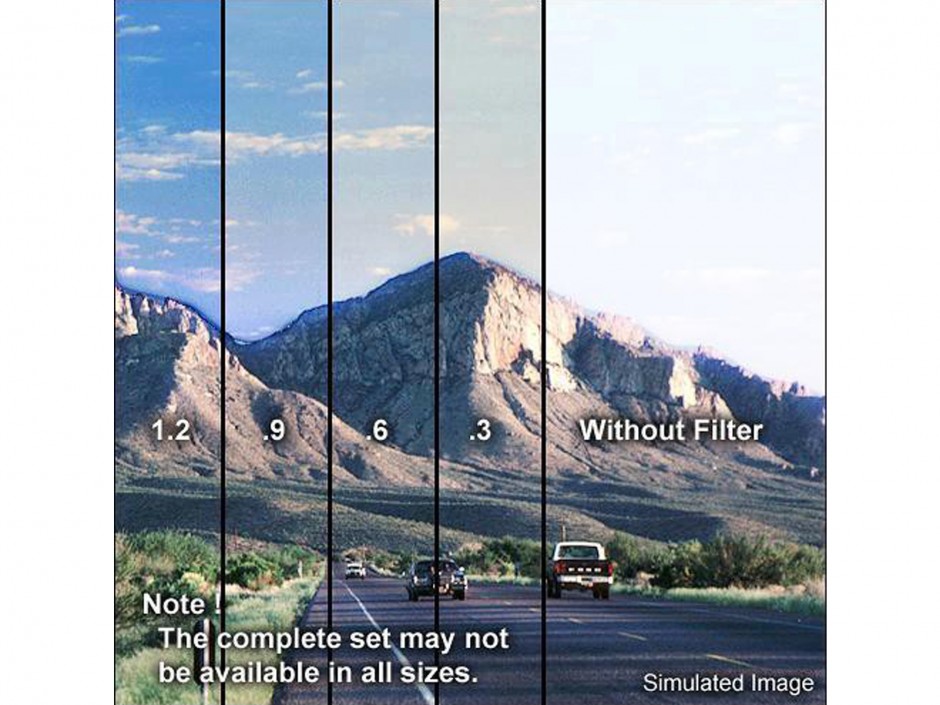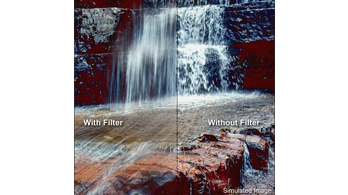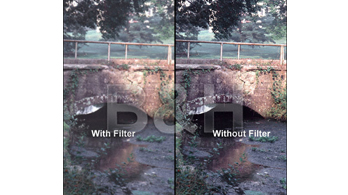The Formatt 4 x 5.65″ Combination 85 Color Conversion/Graduated Neutral Density (ND) 0.3 Glass Filter.
85 Filter
This will produce natural colors when shooting with tungsten film outdoors.
What do you do when you must take some photos outdoors and all you have left is tungsten film? Using tungsten film in daylight will produce a bluish cast in the photograph. The 85 series of filters will “bring back”, i.e. color balance the tones in your images. These yellow filters are used to correct differences in color temperature between the recording medium (film/video) and the light source.
It should be noted that an 85 filter produces slightly cooler results than an 85B (with tungsten film in daylight) whereas an 85B converts tungsten film to daylight. The 85C produces the coolest results – more than either the 85 or 85B. However, it is interesting to remember that an 85C is also useful as a creative warming filter with daylight film in daylight.
Graduated Neutral Density Filter
This enables the shooter to adjust exposure without affecting colour balance. Exposure can be increased by 1,2,3 or 4 stops to suit individual situations.
Often it is necessary or desirable to balance the light intensity in one part of a scene with another. This is especially true in situations where you don’t have total light control, as in bright contrasty landscapes. Exposing for the foreground will produce a washed-out, over-exposed sky while exposing for the sky will leave the foreground dark and under-exposed. This filter enables cloud detail to be kept correctly exposed in the picture.
Determining which graduated neutral density filter yields ideal results for any given lighting situation takes knowledge, experience and a collection of such filters. Choose the filter strength which adjusts the lighting to stay within the exposure latitude (greatest difference between bright/dark values) which still shows details in both of the digital or film medium in use.
Speaking generally, the 2-stop value (ND 0.6 – the filter’s clear portion allows 4x more light to pass vs. darkest portion) effectively compensates average bright sky-to-foreground situations, and the soft transition is applicable more often to a scene than the hard transition.
The Soft or Hard label indicates the degree of color graduation.
Note! Whereas the 85 series is used for tungsten film under daylight conditions, use the 80 series of filters when using daylight film under tungsten lighting
85 Series Conversion Chart
- An 85 decreases the color temperature from 5500-3400K
- An 85A decreases the color temperature from 5500-3100K
- An 85B decreases the color temperature from 5500-3200K
- An 85C decreases the color temperature from 5500-3800K
Neutral Density Filters Have Four Main Uses
- To enable slow shutter speeds to be used, especially with high speed films, to record movement in subjects such as waterfalls, clouds, or cars
- To decrease depth of field by allowing wider apertures to be used, which helps separate subjects from their background
- To decrease the effective ISO of high speed film (above ISO 400) and allow it to be used outdoors in bright situations
- To allow cine and video cameras (which have fixed shutter speeds) to film subjects such as snow, sand or other bright scenes which could cause overexposure
Neutral Density Factors
- ND.3 (exposure adjustment = 1 stop, reduces ISO 1/2)
- ND.6 (exposure adjustment = 2 stops, reduces ISO 1/4)
- ND.9 (exposure adjustment = 3 stops, reduces ISO 1/8)
- ND1.2 (exposure adjustment = 4 stops, reduces ISO 1/16)
Absorbing Cell Technology
- The secret to Formatt’s consistency in filter design lies in its unique “Absorbing Cell Technology” (A.C.T.); This unique process allows color correct dyes to be applied to optically pure, wafer thin absorbing cells and offers a controllability that ensures the smoothest grad lines and consistent color across the whole filter surface
- This process is revolutionary compared with conventional filter dying techniques by eliminating the need to directly coat the glass surface itself. The repeatable performance gained through A.C.T. ensures that at any time you have to swap like filters for like filters mid shoot, you can do so with confidence with no discernable differences in color or density
- Each filter is guaranteed flatness to a maximum 2-wave value and comes with an individual reading from a laser interferometer. Every filter is carefully verified with a densitometer and spectrophotometer to ensure consistent and accurate transmission, before leaving the factory – the result is an absolute purity of image that eliminates any unwanted colorcast caused by conventional greenish soda-lime glass
-
Type Combination Color Conversion/Neutraol Density Size 4 x 5.65″ (100 x 140 mm), 3 mm thick
Hard Edge
Vertical OrientationGrade 0.3 0.6
0.9
1.2
Filter Factor - 85: 1.8 (+2/3 stop)
- ND0.3 : 1-stop – Reduces ISO to 1/2
Multi-Coated Not Applicable Rotating Not Applicable Effect - 85: Removes excessive blue from images and produces more natural colors
- ND: Balanced light intensity from one part of a scene to another
Application - 85: When pleasing color balance is desired when shooting with tungsten film outdoors
- ND: Nature, Travel, Outdoor photography; To maintain light control, as in bright contrasty landscapes; i.e. bright sky, dark foreground
Color Temperature - 85: Decreases the color temperature from 5500-3400K
- ND: Not Applicable
Construction Schott-Desag B270 Crown Optical Glass Front Filter Thread Size Not Applicable Front Lens Cap Size Not Applicable




